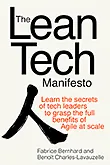Boost team productivity! List of the best Scrum books of all time sorted by rating. The most popular and recommended books for Scrum masters.
Scrum (Jeff Sutherland)
This book is written by one of the co-creators of Scrum, so it can be considered a definitive work on the framework. It goes into depth regarding the main principles, roles, and practices of Scrum in this book—how to work with Scrum. Pragmatic advice on implementation: how to adapt Scrum to your specific context and how to deal with the most common challenges. Case studies in different lines of work show how Scrum can be used to produce success and value to customers. If you want to have a good understanding of and apply Scrum effectively, this is a book for you.Scrum
It makes the history, principles, and practices of Scrum clear, engaging, and accessibly explained just as any human being would understand and be able to do it. Help in implementing Scrum successfully and insight on effective team dynamics, product backlog management, sprint planning, and continuous improvement. Real-world examples, practical tips, and techniques to overcome common challenges and maximize the benefits of Scrum.Essential Scrum
It is a comprehensive introduction to Scrum outlining the principles, practices, and in-depth application. Scrum Master, Product Owner, and team members will be able to get guidelines on how to collaborate, resolve problems, and continue improving. It contains practical examples and a lot of hints in typical problem solution that can happen while processes of Scrum are being optimized.Agile Product Management with Scrum
It presents the critical role of the Product Owner in Scrum and guides, gives advice toward practical steps for effective management of product backlogs, definition of the product vision, and collaboration with stakeholders toward maximum value delivery. This will cover user story mapping, prioritization, release planning, discovery of products, and balancing business goals with technical constraints and user needs.Scrum: A Pocket Guide
Simplified, readable, practical compact explanation of core Scrum principles, roles, events, and artifacts that provide guidance on best applying Scrum practices—tips and tricks—into common challenges. A glossary of the main terms and concepts, quick reference guides for Scrum artifacts, and events are also included in the following document.Scrum Mastery
Focus on the critically important role of the Scrum Master, providing insight, guidance, and practical advice on how a person can be an effective servant leader and a change agent: fostering events, removing impediments, team coaching, and promoting collaboration, transparency, and a culture of continuous improvement. How to handle the most common challenges with real examples, tips, and techniques to set the team up for success.Agile Scrum Crash Course
The book provides a crisp yet holistic view of Scrum and may prove helpful for Scrum newbies or for using it as a handy revision guide. It gives strong basics in Scrum—roles, events, and artifacts—through practical examples and exercises to internalize learning. Basically, the overall objective of the book is to provide the reader with a very strong grounding on the principles of Scrum and its benefits, along with the ability to apply these principles in real life.Scrum Insights for Practitioners
Offers insights at an advanced level, practical advice, and real-life examples for experienced Scrum practitioners seeking deep understanding of Scrum and enhanced effectiveness. Topics include scaling Scrum, working with distributed teams, integration of Scrum with other methodologies, and optimization of the Scrum processes under complex project environments. Presents case studies, tips, and techniques for meeting commonly faced challenges, bringing in higher levels of performance and value delivery.Software in 30 Days
Written by the authors of Scrum, this book sets forth a radical, cutting-edge vision for running software development using the Scrum principles and values. The idea is that, by deep practice of practices in Scrum—which includes self-organization, collaboration, and iterative delivery—the team will be able to come up with high-quality, valuable software in as short a duration as 30 days. It also includes studies, practical guidance, and ways of implementing Scrum in any kind of environment while overcoming the many impediments.Scrum and XP from the Trenches
It is a pragmatic, experience-based trail on how to implement Scrum with the practices of Extreme Programming (XP) in real-life projects. The key practices elaborated in the paper include sprint planning, daily scrum, retrospective, test-driven development, and pair programming. Hints and tips are provided on how to adapt them to the particular circumstances of different organizations and projects. There are experiences in this regard on how to merge Scrum with the XP practices and the lessons learned by the author on his projects.















